Dogs
Hi Julie and Mia,
I wanted to update you on some unique but exciting research that I conducted while working toward my Ph.D. at the University of Florida’s Canine Cognition and Behavior Lab. This particular research focuses on the welfare of wolves and wolf-dog “hybrids” in private sanctuaries.
The common use of the term “hybrid” is perhaps the first indication of how poorly we understand these animals. The term “hybrid” is technically inaccurate – as wolves and domestic dogs are considered taxonomically the same species, so “wolfdog” or “wolf-dog cross” is more accurate. It is estimated that there are 300,000-500,000 wolfdogs in the United States, but a solid census – as well as reliable means of identifying them – is sorely needed. Hundreds of wolfdogs are either euthanized or surrendered to sanctuaries - permanent residences for unwanted, abused and neglected wolves and wolfdogs that cannot be adopted out by shelters.
Although typically filled to capacity, private sanctuaries have little funding opportunities, often relying only modest private donations and volunteers to keep the facility running and ensure that the animals’ needs are adequately met. Consequently, the cost of implementing traditional enrichment items (e.g., toys, objects, scents) to keep the animals stimulated may neither address this goal or prove to be financially feasible.
In many cases, the goal of enrichment for captive animals is not only to increase species-typical behaviors and activity levels, but to reduce or eliminate undesirable behaviors as well.
Interaction with regular, experienced volunteers, however, is an alternative approach. Many animals arrive at sanctuaries with long histories of human interaction, having been obtained by their former owners from breeders at a young age and raised in an environment similar to our pet dogs.
The Research
We observed three pairs of wolfdogs and one pair of wolves, all of which resided for at least six months at Big Oak Wolf Sanctuary in Green Cove Springs, Florida. For years, owners John and Debra Knight and their volunteers have prioritized daily human interaction sessions to their animals without the use of food-based reinforcers. This provided a unique opportunity for me to examine the effects of human interaction alone on the animals’ behavior.
Was there any scientific merit to my observations, or did I simply just want to believe that these animals were responding positively to their new lives? This also seemed to be an ideal opportunity to investigate whether human interaction was a a legitimate enrichment strategy for a captive animal population.
The Findings
For all subjects, the levels of positive, species-typical affiliative behaviors significantly increased, as did their overall activity levels. Remarkably, subjects also spent significantly more time playing with the other animal in their enclosure when human interaction was provided. In this way, it appears that human interaction also enhances the behaviors between the paired animals.
Three wolfdogs also exhibited pacing (widely considered a stereotypic behavior in captive animals) in initial baselines. The pacing was either reduced substantially or eliminated during all human interaction sessions.
These findings, published in the most recent issue of the Journal of Applied Animal Welfare Science, collectively support the notion that human interaction is in itself enriching for well-socialized wolves and wolfdogs. Needless to say, these results did not come as a surprise to volunteers at Big Oak who have spent countless hours closely interacting with their animals. More data is certainly needed to determine if this effect is true for other wolves and wolfdogs at other sanctuaries, as well as the long-term effects of human interaction on behavioral welfare.
Although the lack of scientific studies on wolfdog behavior leaves many opportunities to scientists interested in studying them, it poses a difficulty for the general public who seek objective, reliable information on wolfdogs. So, I think it’s worth ending with some recommendations for future reading.
You will likely come to find that everyone has their own opinion on wolfdogs – and that is because no two wolfdogs are the same; nor are any of our experiences with them identical. I hope you’ve enjoyed reading, and I look forward to research that continues to examine ways of further improving the welfare of these wonderful – but often misunderstood – animals.
Best,
Lindsay R. Mehrkam
Ph.D. Candidate
Canine Cognition & Behavior Lab
University of Florida
PS: Big Oak Wolf Sanctuary is in need of donations. Details here: http://www.bigoakwolfsanctuary.org/donate.asp
Further Reading:
Mehrkam L.R., Verdi N.T. & Wynne C.D.L. (2014). Human Interaction as Environmental Enrichment for Pair-Housed Wolves and Wolf–Dog Crosses, Journal of Applied Animal Welfare Science, 17 (1) 43-58. DOI: 10.1080/10888705.2014.856246
Addams, J., & Miller, A. (2012). Between dog and wolf: understanding the connection and the confusion. Wenatchee, WA: Dogwise Publishing.
Photos: Copyright Big Oak Wolf Sanctuary
- Can Dogs Read Minds?
By Linda Cole After thousands of years of domestication, scientists have finally begun to do more extensive research on dogs to try to better understand man's best friend and how they relate to us. Most of us have already figured out that a positive...
- New Research Explains Why Dogs Aren't Wolves
By Linda Cole I admire the spirit of wolves, an animal who has found the world to be a hostile place, even though man has embraced a species that was born from them. There are similarities between dogs and wolves, but dogs are not wolves. The reason why...
- Do Wolf-dog Hybrids Make Good Pets?
By Linda Cole I had an opportunity to see a wolf-dog hybrid several years ago. He was a magnificent animal, taller and heavier than a wolf. His father was a pure black wolf with intense amber eyes that followed my every move. The breeder who had the...
- The Origin Of The Domesticated Dog
The domestic dog, aka Canis lupus familiaris, originated in the domestication of the gray wolf (Canis lupus). The domestication process continues even today, if we consider the fact that the cross-breeding of dogs in order to create "designer dogs"...
- Learn About A Dying Species - Facts About Wolves
When man was young on the Earth, millions of wolves roamed world wide. Today, due to centuries of hunting for sport, be it legal or illegal, there are little more than 300,000 wolves left in the world. Wolves are the largest of the canine breed and are...
Dogs
Scientific Approaches to Enriching the Lives of Sanctuary Wolves and Wolf-Dog “Hybrids”
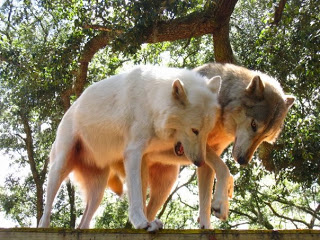 |
| Spirit initiating play with Sampson |
I wanted to update you on some unique but exciting research that I conducted while working toward my Ph.D. at the University of Florida’s Canine Cognition and Behavior Lab. This particular research focuses on the welfare of wolves and wolf-dog “hybrids” in private sanctuaries.
The common use of the term “hybrid” is perhaps the first indication of how poorly we understand these animals. The term “hybrid” is technically inaccurate – as wolves and domestic dogs are considered taxonomically the same species, so “wolfdog” or “wolf-dog cross” is more accurate. It is estimated that there are 300,000-500,000 wolfdogs in the United States, but a solid census – as well as reliable means of identifying them – is sorely needed. Hundreds of wolfdogs are either euthanized or surrendered to sanctuaries - permanent residences for unwanted, abused and neglected wolves and wolfdogs that cannot be adopted out by shelters.
Although typically filled to capacity, private sanctuaries have little funding opportunities, often relying only modest private donations and volunteers to keep the facility running and ensure that the animals’ needs are adequately met. Consequently, the cost of implementing traditional enrichment items (e.g., toys, objects, scents) to keep the animals stimulated may neither address this goal or prove to be financially feasible.
In many cases, the goal of enrichment for captive animals is not only to increase species-typical behaviors and activity levels, but to reduce or eliminate undesirable behaviors as well.
Interaction with regular, experienced volunteers, however, is an alternative approach. Many animals arrive at sanctuaries with long histories of human interaction, having been obtained by their former owners from breeders at a young age and raised in an environment similar to our pet dogs.
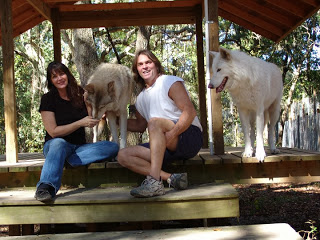 |
| Big Oak founders Debra & John Knight with Sampson & Spirit |
We observed three pairs of wolfdogs and one pair of wolves, all of which resided for at least six months at Big Oak Wolf Sanctuary in Green Cove Springs, Florida. For years, owners John and Debra Knight and their volunteers have prioritized daily human interaction sessions to their animals without the use of food-based reinforcers. This provided a unique opportunity for me to examine the effects of human interaction alone on the animals’ behavior.
Was there any scientific merit to my observations, or did I simply just want to believe that these animals were responding positively to their new lives? This also seemed to be an ideal opportunity to investigate whether human interaction was a a legitimate enrichment strategy for a captive animal population.
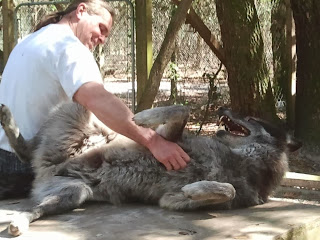 |
| John Knight spends some quality time with Job |
The Findings
For all subjects, the levels of positive, species-typical affiliative behaviors significantly increased, as did their overall activity levels. Remarkably, subjects also spent significantly more time playing with the other animal in their enclosure when human interaction was provided. In this way, it appears that human interaction also enhances the behaviors between the paired animals.
Three wolfdogs also exhibited pacing (widely considered a stereotypic behavior in captive animals) in initial baselines. The pacing was either reduced substantially or eliminated during all human interaction sessions.
These findings, published in the most recent issue of the Journal of Applied Animal Welfare Science, collectively support the notion that human interaction is in itself enriching for well-socialized wolves and wolfdogs. Needless to say, these results did not come as a surprise to volunteers at Big Oak who have spent countless hours closely interacting with their animals. More data is certainly needed to determine if this effect is true for other wolves and wolfdogs at other sanctuaries, as well as the long-term effects of human interaction on behavioral welfare.
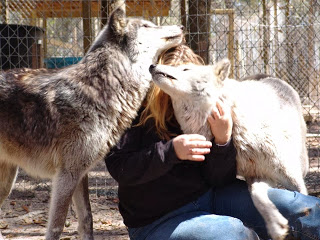 |
| Volunteer Debbie Costa gets scent rubs from Amos & Angel |
Although the lack of scientific studies on wolfdog behavior leaves many opportunities to scientists interested in studying them, it poses a difficulty for the general public who seek objective, reliable information on wolfdogs. So, I think it’s worth ending with some recommendations for future reading.
You will likely come to find that everyone has their own opinion on wolfdogs – and that is because no two wolfdogs are the same; nor are any of our experiences with them identical. I hope you’ve enjoyed reading, and I look forward to research that continues to examine ways of further improving the welfare of these wonderful – but often misunderstood – animals.
Best,
Lindsay R. Mehrkam
Ph.D. Candidate
Canine Cognition & Behavior Lab
University of Florida
PS: Big Oak Wolf Sanctuary is in need of donations. Details here: http://www.bigoakwolfsanctuary.org/donate.asp
Further Reading:
Mehrkam L.R., Verdi N.T. & Wynne C.D.L. (2014). Human Interaction as Environmental Enrichment for Pair-Housed Wolves and Wolf–Dog Crosses, Journal of Applied Animal Welfare Science, 17 (1) 43-58. DOI: 10.1080/10888705.2014.856246
Addams, J., & Miller, A. (2012). Between dog and wolf: understanding the connection and the confusion. Wenatchee, WA: Dogwise Publishing.
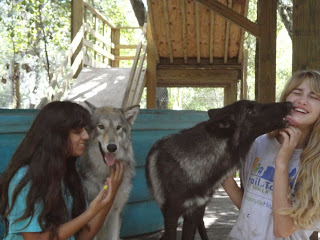 |
| Volunteers Maya and Sarah with pups Abigail and India |
Photos: Copyright Big Oak Wolf Sanctuary
- Can Dogs Read Minds?
By Linda Cole After thousands of years of domestication, scientists have finally begun to do more extensive research on dogs to try to better understand man's best friend and how they relate to us. Most of us have already figured out that a positive...
- New Research Explains Why Dogs Aren't Wolves
By Linda Cole I admire the spirit of wolves, an animal who has found the world to be a hostile place, even though man has embraced a species that was born from them. There are similarities between dogs and wolves, but dogs are not wolves. The reason why...
- Do Wolf-dog Hybrids Make Good Pets?
By Linda Cole I had an opportunity to see a wolf-dog hybrid several years ago. He was a magnificent animal, taller and heavier than a wolf. His father was a pure black wolf with intense amber eyes that followed my every move. The breeder who had the...
- The Origin Of The Domesticated Dog
The domestic dog, aka Canis lupus familiaris, originated in the domestication of the gray wolf (Canis lupus). The domestication process continues even today, if we consider the fact that the cross-breeding of dogs in order to create "designer dogs"...
- Learn About A Dying Species - Facts About Wolves
When man was young on the Earth, millions of wolves roamed world wide. Today, due to centuries of hunting for sport, be it legal or illegal, there are little more than 300,000 wolves left in the world. Wolves are the largest of the canine breed and are...
